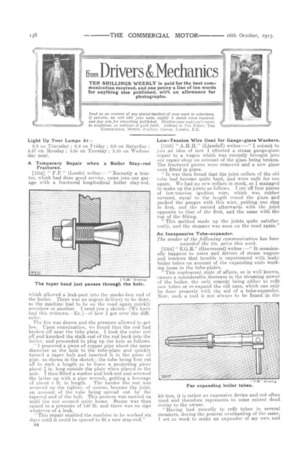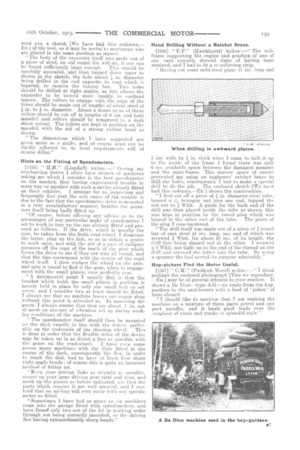hni Drivers &Mechanics
Page 18

Page 19

If you've noticed an error in this article please click here to report it so we can fix it.
TEN SHILLINGS WEEKLY is paid for the best communication received, and one penny a line of ten words for anything else published, with an allowance for photographs.
Light Up Your Lamps At — 6.5 on Thursday; 6.2 on Friday ; 6.0 on Saturday: 5.57 on Monday ; 5.55 on Tuesday ; 5.53 on Wednesday next.
A Temporary Repair when a Boiler Stay-rod Fractured.
[1352] " P.P." (Leeds) writes :—" Recently a tractor, which had done good service, came into our garage with a fractured longitudinal boiler stay-rod,
which allowed a leak-past into the smoke-box end of the boiler. There was an urgent delivery to be done, so the machine had to be on the road again quickly somehow or another. I send you a sketch-7e have had this redrawn.—En.]-'---of how I got over the difficulty.
The fire was drawn and the pressure allowed to get low. Upon examination, we found that the rod had broken off near the tube plate. I took the outer nut off and knocked the stalk-end of the rod back into the boiler, and proceeded to plug up the hole as follows.
"I procured a piece of copper pipe about the same diameter as the hole in the tube-plate and quickly turned a taper bolt and inserted it in the piece of pipe, as shown in the sketch ; the tube being first cut off to such a length as to leave a projecting piece about ; in. Tong outside the plate when placed in the hole. I then fitted a washer and lock-nut and screwed the latter up with a pipe wrench, getting a leverage of about 4 ft. in length. The harder the nut was screwed up the tighter, of course, became the joint, on account of the tube being spread out by the tapered end of the bolt. This process was carried on until the nut seemed quite home. Steam was then raised to a pressure of 140 lb. and there was no sign whatever of a leak.
" This repair enabled the machine to be worked six days until it could be spared to fit a new stay-rod." D4
Low-Tension Wire Used for Gauge-glass Washers.
[1353]" A.H.H." (Llandaff) writes :—" I submit to you an idea of how I effected a steam gauge-glass repair to a wagon which was recently brought into our repair shop on account of the glass being broken. The fractured pieces were removed and a new glass. soon fitted in place.
"It was then found that the joint collars of the old tube had become quite hard, and were unfit for use again. We had no new collars in stock, so I managed to make up the joints as follows. I cut off four pieces of low-tension ignition wire, which was rubber covered, equal to. the length round the glass and packed the gauges with this wire, putting one ring in first, and the second afterwards with the joint opposite to that of the first, and the same with the top of the fitting. "This method made up the joints quite satisfactorily, and the steamer was soon on the road again.'.'
An Inexpensive Tube-expander.
The sender of the following communication has been awarded the Ws. prize this week.
[1354] " E.G.R." (Gravesend) writes :—" It occasionally happens to users and drivers of steam wagons and tractors that trouble is experienced with leaky. boiler tubes on account of the expanding ends working loose in the tube-plates.
"This unpleasant state of affairs, as is well known, causes a considerable decrease in the steaming power of the boiler, the only remedy being either to refit new tubes or re-expand the old ones, which can only be done properly with the aid of a tube-expander. Now, such a tool is not always to be found in the send you a sketch [We have had this redrawn.— BD. j of the tool, as it may be usetul to mechanics who are placed in the same position as myself. "'the body of the expander itself was made out of a piece of steel, an old round file will do, if one can be found sufficiently large enough. This should be carefully annealed, and then turned down taper as shown in the sketch, the hole about in. diameter being drilled in the end opposite to that which is tapered, to receive the tommy bar. Two holes should be drilled at right angles, as this allows the expander to be turned more readily in confined spaces. The rollers to engage with the edge of the tubes should be made out of lengths of silver steel of in. to in. diameter. About a dozen or so of these rollers should be cut off in lengths of 6 ins, and both mandril and rollers should be tempered to a dark straw colour. The rollers are kept in position on the mandril with the aid of a strong rubber band as shown.
." The dimensions which I have suggested are given more as a guide, and of course need not be rigidly adhered to, as local requirements will of course differ."
Hints on the Fitting of Speedometers.
[1355] " H.H." (Llandaff) writes :—" During my overhauling duties I often have owners of machines
asking me which I consider is the best speedometer on the market, they having experienced trouble in some way or another with such a device already fitted on their vehicles. I arrange for an inspection and frequently find that the sole cause of the trouble is due to the fact. that the speedometer drive is mounted in a very unsatisfactory manner, besides the accessory itself being badly fitted up.
"Of course, before offering any advice as to the advantages of any particular make of speedometer I
set to work to true up the one already fitted and pro ceed as follows. If the drive, which is usually the case, be taken from the front road-wheel. I dismount
the latter, plug up the hub, so as to obtain a centre to work upon, and with the aid of a pair of callipers measure off the tops of the teeth of the gear which forms the drive to see if they are true all round, and that the tips correspond with the centre of the road wheel itself. I then replace the wheel en the axle, and spin it round to find if the gear, when in engagement with the, small pinion, runs perfectly true. "A detrimental point I usually find is that the bracket which holds the small pinion in position is merely held in place by only one small halt or set screw, and I consider two at least should befitted. I always see that no machine leaves our repair shop without this point is attended to. In mounting the gears, I always ensure that they are about in. out of mesh on account of vibration set up during working conditions of the machine.
"The speedometer itself should then be mounted on the dash exactly in line with the driver, preferably on the underside of the steering wheel. This is done in order that the flexible drive of the device may be taken up in as direct a line as possible with the gears on the road-wheel. I have even come across many machines with the dials fitted in the centre of the dash, consequently the flex, in order to reach the dial, had to have at least four sham right-angle bends ; of course this is quite an incorrect method of fitting UM "Keep your driving links as straight as poasible, mount up your large driving gear rigid and true, and mesh up the pinion as before indicated. see that the parts which require it are well greased, and I contend that no mishap will ever occur with any speedometer so fitted.
"Sometimes I have had as many as six machines come into the garage fitted with speedometers, and have found only two out of the lot in working order through not being correctly mounted, or the driving flex having extraordinarily sharp bends." Hand Drilling Without a Ratchet Brace.
[1356] " E.P." (Hawkhurst) writes :—" The subframe supporting the engine and gearbox of one of our vans recently showed signs of having been strained, and I had to fit a re-enforcing strip.
" Having cut some mild-steel plate 15 ins, long and
3 ins, wide by in. thick when I came to bolt it up to the inside of the frame I found there was only 6 ins, available space between the damaged member and the main-frame. This narrow space of course prevented my using an engineers' ratchet brace to drill the holes, consequently I had to make a special drill to do the job. The enclosed sketch [We have had this redrawn.—En.] shows the construction. "I first cut off a piece of .1 in. diameter steel tube, brazed a s'a hexagon nut into one end, tapped the nut out to # Whit. A guide for the back end of the drill was then placed inside the tube as shown, this was kept in position by the coned plug which was brazed in the other end of the tube. The point of the plug I case-hardened.
"The drill itself was made out of a piece of # round bar of cast steel 4-4 ins, long, one end of which was screwed # Whit. for about 2i ins, of its length, the drill face being shaped out at the other. I screwed a # Whit. nut tight up to the end of the thread on the drill and screwed the latter into the tube. By using a spanner the tool served its purpose admirably."
Hop-pickers Find the Motor Useful.
[1357] " CM." (Paddock Wood) writes :—" I think perhaps the enclosed photograph [This we reproduce. —En.] may be of general interest to your readers. It shows a De Dion—type A.G.—en route from the hopgardens to the oast-houses with a load of pokes of hops aboard.
"I should like to mention that I am running the machine on a mixture of three parts petrol and one part paraffin, and it hauls good loads over the roughest of roads and tracks in splendid style."




















